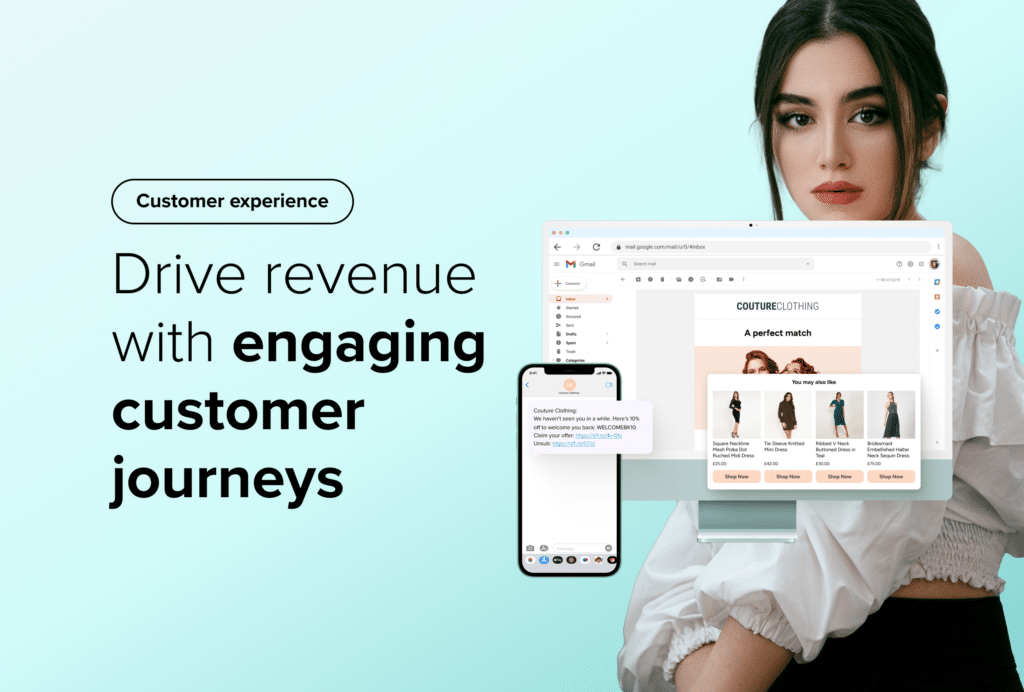How to Improve Online Customer Experiences in eCommerce | A 2023 Guide
By Bethany Llewellyn • Last updated: Tuesday Jun 4th, 2024

Every day, the digital marketplace is becoming more crowded with countless eCommerce retailers competing for the attention of customers.
The rise of artificial intelligence and rapid technological advancements have led today’s online customers to expect a seamless, hyper-personalised shopping experience.
In this blog, we’ll share the best practices to improve your eCommerce site’s customer experiences and explore the new technologies you can harness to drive more revenue.

Understanding the importance of your customer’s experience
The eCommerce space has been evolving dramatically over the years, and in 2023, the stakes are higher than ever.
It’s no longer just about the product or service you offer, it’s about how your customers feel when they interact with your brand, and that’s where the importance of customer experience comes into play.
The customer experience goes beyond the boundaries of your eCommerce website. It starts from the initial interaction with your brand through to post-purchase follow-ups.
It encompasses every touchpoint with your business such as:
- Customer service interactions: The better your customer support, the better experience your customers will have. Whether you have an FAQs page or offer live chat, since customers know they’re able to receive support when they need it, it will encourage them to complete the checkout process quicker.
- Social media engagement: In the age of social media and customer reviews, consumers hold the power. Happy customers can become brand advocates that spread positive word-of-mouth recommendations to family and friends.
- Post-purchase email campaigns: Showing the customer that you value them not only whilst they’re on their buying journey, but also after they’ve made a purchase, will build trust and loyalty within your customer base.
A positive customer experience can turn first-time shoppers into repeat customers, but a single negative experience can drive potential customers away for good.
What you can do: While some eCommerce fads come and go, hyper-personalisation and artificial intelligence are two trends that are revolutionising the way customers are shopping in 2023 – and they’re here to stay.
Integrating these trends into your strategy is how you can ensure you’re meeting the needs of your customers in 2023.
You can stay up to date with the latest trends and consumer buying habits by using an analytics platform like Trends that displays real-time data on a variety of metrics, such as revenue, conversion rate and average order value.
Analysing buying patterns from previous years will help you to make informed business decisions going forward and create reactive strategies that take your campaigns to new heights.
How to improve the eCommerce customer experiences
1. Harness the power of new technologies
Nowadays, customers demand speed, convenience and intuitive interactions when shopping online.
Introducing the latest technology on your website will help you:
- Improve customer experiences: Enhancing the tech on your site is the key to simplifying customer journeys. This can shorten the time they spend trawling through your product catalogue and enable them to reach their desired product quicker.
- Stand out from the competition: Set yourself ahead of your competitors by introducing the latest innovations and technologies in eCommerce on your site. You can be sure that you’re providing your customers with exciting online shopping journeys from the moment they land on your site that encourages them to return time and again.
- Save time and resources: Technology, especially artificial intelligence, is every eCommerce marketer and business owner’s best friend. With high capabilities, such as automatic data collection or customer behaviour monitoring tools, you can allow the tech on your site to do the heavy lifting for you.
Features like voice search or AI-powered on-site assistants can revolutionise the shopping experience and make product discovery and purchase decisions faster and more convenient.
Take a look at Amazon, they have successfully utilised voice search technology to simplify shopping, contributing to its status as a global eCommerce leader, and you can too.
What you can do on-site: Introduce innovative technology like Visually Similar Search to your website.
Visual search is increasingly popular and is revolutionising the way consumers browse product pages, with 74% of shoppers searching via imagery to find the right products online.1
This AI-powered tool gives shoppers the power to search using imagery, inspiring product interaction and purchases.
By delivering similar product results to customers quickly and seamlessly, you can transform the online customer experience, increase product discovery and encourage more sales from satisfied customers.
Suggested reading: We cover all you need to know in our article, ‘6 Not So Obvious Benefits of Visual Search for eCommerce Businesses’
2. Introduce on-site personalisation
Personalisation can dramatically enhance the online shopping experience.
74% of customers feel frustrated when website content is not personalised, and a further 57% of customers are willing to provide personal information in exchange for a shopping experience that’s tailored to them.2
These stats show that utilising personalisation tools and strategies on your site not only makes your customers feel valued but also encourages the likelihood of them returning to your site time and again.
Pro tip: If a customer was browsing a specific kind of shoe, you can use Recommendations to display items that are similar in style and colour or items that work well with the product, like socks or shoe laces.
With various strategies, such as Bought Together, Personalised, or Most Popular, you can choose the algorithm that will work best for your customers.
This recommendations-based way to show customers related products will encourage upsells and cross-sells, but most of all, secure purchases from customers by ensuring they find a product that works for them.

3. Optimise your marketing communications
Generic, one-size-fits-all marketing is out. Personalised marketing is in.
Using the array of customer data available to you combined with AI-powered personalisation tools, you can create unique, effective campaigns that generate more revenue for your business.
Integrating your marketing efforts in line with customers’ online browsing habits allows you to display timely and relevant promotions that convert more often.
What you can do: When a customer abandons their shopping cart it no longer means a lost sale. Instead, it provides an opportunity for personalised communications through your email marketing campaigns.
With an optimised post-purchase strategy in place, you can send a personalised cart abandonment email reminding them of what they left behind.
This tailored approach adds value to the shopping experience and can turn an abandoned cart into a completed purchase.
4. Use UX to support shopper journeys
User experience (UX) is crucial to the overall satisfaction of your customers and the success of your business, and it starts with your web design.
When designing your site, you should always keep the user experience at the forefront of your mind.
You want to provide a seamless shopping experience that’s both smooth and easy to navigate from the moment a user lands on your site right through to the checkout page.
Here are a few things to consider when designing your website:
- Load time: 47% of shoppers expect a webpage to load in two seconds or less.3
- Mobile-first approach: 67% of mobile phone users state that pages and links are often too small to click on.4 Ensuring your website is optimised for both desktop and mobile will secure more sales from these shoppers.
- Easy navigation: 37% of users say that poor navigation and design cause them to leave websites.5 Over time, this can result in a huge amount of lost revenue, so making small changes to your UX design and navigation can yield great results.
One of the most effective ways to support customer journeys is through targeted messaging. With Digital Assistant, there are a variety of free campaigns that you can display on your site to help guide your customers through the buying journey.
You have complete customisable control of Digital Assistant, from the branding, messaging, colours and campaigns – all enhancing the user experience while simultaneously boosting sales.
Pro tip: Your customer service, live chat functionality and FAQs are also crucial to improving customer experiences and these shouldn’t be neglected.
This will help your customers make shopping decisions easier and quicker.
5. Prepare for the rise of mCommerce
Mobile compatibility is no longer an option; it’s a necessity. mCommerce has truly taken the world by storm and it can result in lost sales if your site isn’t optimised.
With a surge in shopping through smartphones, your online store needs to be optimised for the huge amount of mobile shoppers in 2023. A recent study reported that mobile shopping accounts for almost 60% of total global online traffic.6
Creating a mobile-friendly website comes with an array of benefits, including:
- Improved customer experiences: Create a hassle-free shopping experience that allows shoppers to browse items the way they want to, no matter what device they’re on.
- Reaching a wider audience: Mobile shopping allows you to enter new markets that you couldn’t before. With an optimised site, you’re opening your business to a huge amount of potential customers and sales.
- The better pull of data and analytics: Mobile generates a larger pool of customer data due to high traffic and frequent use, in turn, this can inform your future campaigns and strategies to maximise each customer who visits your site.
Pro tip: Beyond just mobile compatibility, linking your eCommerce site to your social media channels enables users to engage with your brand on various platforms.
Shopping through social media is becoming increasingly popular, with 52% of customers worldwide saying social media has influenced their shopping decisions.7
Plus, it provides an enhanced level of connection with your customers. It’s a great way to:
- Engage with your audience
- Improve brand recognition
- Build stronger customer relationships
- Increase user-generated content
Overall, optimising your site for the mobile shopper will help you improve the customer experience and generate more sales.

Conclusion: How you can transform the customer experience
As the eCommerce landscape continues to evolve and grow in 2023, the focus remains firmly on the customer.
By incorporating these best practices and strategies into your online store, you can create an enjoyable and personalised shopping experience for your customers, enhancing loyalty and ultimately driving business growth.
It’s key to remember that customer experiences don’t start and end with your website, but it encompasses the entire journey a user has with your business.
Striving to provide an end-to-end, optimised customer service experience is a sure way to ensure your business thrives in 2023 and beyond.
1 The State of Visual Search | Invesp
2 68 Personalisation Statistics Every Digital Advertiser Must Keep in Mind | Instapage
3 How fast should a website load in 2023? | Hobo SEO Consultancy
4 Top 10 Mobile Commerce Statistics for 2023 | Tidio
5 27 Latest Website Statistics For 2023 | Blogging Wizzard
6 Mobile Internet Usage Worldwide | Statista
7 23 Thrilling Social Commerce Statistics | Fashion Discounts
Transform the customer experience with intelligent conversion tools. Salesfire has a range of personalisation conversion tools that create unique, seamless journeys – reach out to one of our experts at [email protected] or book a demonstration.



